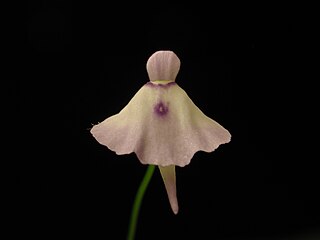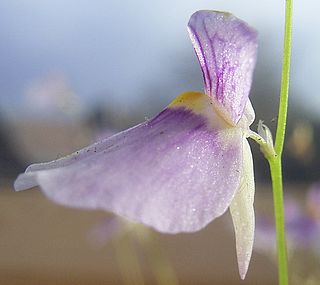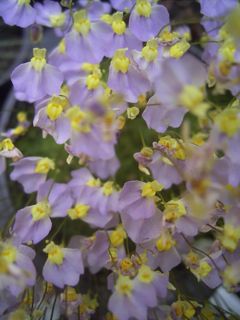Utricularia stygia, the arctic bladderwort or Northern bladderwort, is an affixed aquatic carnivorous plant that belongs to the genus Utricularia. U. stygia is native to northern Europe and North America. This species was originally published by Göran Thor in 1987 but the description was not in Latin and was therefore nomenclaturally invalid. Thor validly published the species a year later. The cited difference that separates U. stygia from U. ochroleuca is the shape of the tiny quadrifid glands inside the bladders, specifically at which angle the "arms" of these glands diverge from one another. Thor, when working on the Utricularia of Sweden noted that this distinction alone allowed for consistent species identification. Both Barry Rice and Peter Taylor have expressed concerns regarding how this method applies to other populations around the world.
Utricularia podadena is a small, probably perennial, terrestrial carnivorous plant that belongs to the genus Utricularia and is the only member of Utricularia sect. Candollea. U. podadena is endemic to Malawi and Mozambique, being known only from the type location in Malawi and from one other collection in Mozambique. As of Peter Taylor's 1989 monograph on the genus, more recent efforts to locate this species have failed. It was originally published and described by Taylor in 1964 and placed in its own section, Candollea, in 1986. It grows as a terrestrial plant in marshy grasslands in the presence of Loudetia species at altitudes of around 1,000 m (3,281 ft). It flowers in July. It is a very distinct plant in the genus with the long stipitate glandular trichomes covering the flower. Its affinities within the genus are not clear.
Utricularia sect. Meionula is a section in the genus Utricularia. The four species in this section are small terrestrial carnivorous plants native to Southeast Asia and Australia. Constantine Samuel Rafinesque originally published some of the species in this section under two genera, Meionula and Trixapias, in 1838. Peter Taylor published the section as it currently stands in 1986, including three additional Australian and New Zealand species which are now circumscribed in their own section, Australes.
Peter Geoffrey Taylor (1926–2011) was a British botanist who worked at Royal Botanic Gardens, Kew throughout his career in botany. Taylor was born in 1926 and joined the staff of the herbarium at Kew in 1948. He published his first new species, Utricularia pentadactyla, in 1954. In 1973, Taylor was appointed curator of the orchid division of the herbarium and, according to Kew, "under his direction, orchid taxonomy was revitalised and its horticultural contacts strengthened."
Utricularia guyanensis is a small, probably perennial, terrestrial carnivorous plant that belongs to the genus Utricularia and is the only member of Utricularia sect. Stylotheca. U. guyanensis is native to Central and South America. It grows as a terrestrial plant on wet or damp sandy savannas at lower altitudes, but up to 1,100 m (3,609 ft) in Bolívar. It has been collected in flower between January and November. It was originally published and described by Alphonse Pyrame de Candolle in 1844 and placed in its own section, Stylotheca.
Utricularia sect. Kamienskia is a section in the genus Utricularia. The two species in this section are very small bryophilous lithophytic carnivorous plants. Peter Taylor originally described and published the section and its single species, Utricularia peranomala, in 1986. In 2007, Guang Wan Hu described Utricularia mangshanensis and placed it in this section. Both species are endemic to China.
Utricularia viscosa is a small to medium sized perennial, terrestrial or subaquatic carnivorous plant that belongs to the genus Utricularia and is the only member of Utricularia sect. Sprucea. U. viscosa is native to Central America and South America. It grows as a terrestrial or subaquatic plant in wet sandy savannas at lower altitudes but as high as 900 m (2,953 ft) in Guyana. It was originally named by Richard Spruce and formally described by Daniel Oliver in 1860. In 1986, Peter Taylor placed this species in its own section, Sprucea, which was named in honor of Richard Spruce.

Utricularia subg. Bivalvaria is a subgenus in the genus Utricularia. It was originally described by Wilhelm Sulpiz Kurz in 1874. In Peter Taylor's 1989 monograph on the genus, he reduced the subgenus to synonym under section Oligocista, a decision that was later reversed in the light of molecular phylogenetic studies and the subgenus was restored.

Utricularia pubescens is a small to medium-sized, probably annual, terrestrial or lithophytic carnivorous plant that belongs to the genus Utricularia and is the only member of Utricularia sect. Lloydia. U. pubescens is native to India, tropical Africa, and Central and South America. It was originally published and described by James Edward Smith in 1819 and placed in its own section, Lloydia, by Peter Taylor in 1986. It grows as a terrestrial or lithophytic plant in boggy grasslands in damp peaty soils at altitudes from sea level to 1,900 m (6,234 ft). This species possesses small peltate leaves, which are diagnostic for this species in the genus.
Utricularia sect. Avesicarioides is a section in the genus Utricularia. The two species in this section are small rheophytic carnivorous plants native to western Africa. Sadashi Komiya originally described and published this section in his 1973 taxonomic treatment of the genus. Peter Taylor revised and refined the section in his 1989 monograph on the genus.
Utricularia sect. Enskide is a section in the genus Utricularia. The two species in this section are small to medium-sized terrestrial carnivorous plants native to Australia and New Guinea. Constantine Samuel Rafinesque originally described and published this section as a separate genus in his 1838 taxonomic treatment. Peter Taylor refined the section and placed it within subgenus Utricularia in his 1986 monograph of the genus. Later molecular data resulted in the revision of Taylor's treatment, reinstating subgenus Bivalvaria and placing this section within it.

Utricularia sect. Stomoisia is a section in the genus Utricularia. The two species in this section are small to medium-sized terrestrial carnivorous plants native to North, Central, and South America. Constantine Samuel Rafinesque originally described and published this section as a separate genus in his 1838 taxonomic treatment. Otto Kuntze reduced the genus to its current status as a section in the genus Utricularia in 1903. Peter Taylor later refined the section, placing it in subgenus Utricularia in his 1986 monograph of the genus, also bringing one of Rafinesque's other genera, Personula, into synonymy with the new section. Later molecular data resulted in the revision of Taylor's treatment, reinstating subgenus Bivalvaria and placing this section within it.

Utricularia sect. Australes is a section in the genus Utricularia. The three species in this section are small terrestrial carnivorous plants native to Australia and New Zealand. Peter Taylor originally described and published this section in his 1989 taxonomic treatment of the genus, splitting off species from section Meionula. Taylor originally placed this section within subgenus Utricularia. More recent phylogenetic data and revisions have reinstated subgenus Bivalvaria and have placed this section within it.

Utricularia sect. Nigrescentes is a section in the genus Utricularia. The three species in this section are small terrestrial carnivorous plants native to tropical Africa, Asia, and Australia. Daniel Oliver originally validly described and published this section in 1859, but did not specify the rank used by the group. Sadashi Komiya revised the section in 1973. Peter Taylor, in his 1989 taxonomic monograph on the genus, placed this section within subgenus Utricularia. More recent phylogenetic data and revisions have reinstated subgenus Bivalvaria and have placed this section within it.

Utricularia sect. Aranella is a section in the genus Utricularia. The ten species in this section are small terrestrial carnivorous plants native to tropical South America with one species also extending into tropical Africa. John Hendley Barnhart originally described and published this section in 1913 as a separate genus, Aranella. Sadashi Komiya revised the genus Utricularia in a 1973 taxonomic review and placed Barnhart's genus at the rank of subgenus within Utricularia. Peter Taylor then published his taxonomic monograph of Utricularia in 1986 in which he reduced Komiya's subgenus to the rank of section, placing it within subgenus Utricularia. More recent phylogenetic data and revisions have reinstated subgenus Bivalvaria and have placed this section within it.

Utricularia sect. Calpidisca is a section in the genus Utricularia. The ten species in this section are small terrestrial carnivorous plants native to Africa with one species extending its range into Mexico and another that extends into Asia as far as India. John Hendley Barnhart originally described and published this section in 1916 as a separate genus, Calpidisca. Sadashi Komiya revised the genus Utricularia in a 1973 taxonomic review and placed Barnhart's genus at the rank of section within Utricularia. Peter Taylor then published his taxonomic monograph of Utricularia in 1986 in which he placed Komiya's section within subgenus Utricularia. More recent phylogenetic data and revisions have reinstated subgenus Bivalvaria and have placed this section within it.
Utricularia simmonsii is a small annual or perennial terrestrial carnivorous plant that belongs to the genus Utricularia and is the only member of Utricularia sect. Minutae. U. simmonsii is endemic to Australia and is only known from a few locations in the Northern Territory and Queensland. It and the section Minutae were originally published and described by Allen Lowrie, Ian D. Cowie, and John Godfrey Conran in 2008. It was named in honor of Paul Simmons, who discovered the species in Queensland in 2005.
Utricularia sect. Phyllaria is a section in the genus Utricularia. The sixteen species in this section are small or very small lithophytic or epiphytic carnivorous plants native to the mountains of Asia, ranging from India to China and New Guinea. One species, Utricularia striatula, is an exception and is widespread in much of the Old World tropics. Wilhelm Sulpiz Kurz originally described and published this section as Utricularia subg. Phyllaria in 1874. Franciszek Kamieński reviewed the genus in 1891 and reduced Kunz's subgenus to a section. Later botanists, including Peter Taylor, agreed with Kamieński's assessment. In Taylor's 1986 revision of the genus, he placed this section in subgenus Utricularia. Later molecular data resulted in the revision of Taylor's treatment, reinstating subgenus Bivalvaria and placing this section within it.

The Genus Utricularia: A Taxonomic Monograph is a monograph by Peter Taylor on the carnivorous plant genus Utricularia, the bladderworts. It was published in 1989 by Her Majesty's Stationery Office (HMSO) as the fourteenth entry in the Kew Bulletin Additional Series. It was reprinted for The Royal Botanic Gardens, Kew in 1994.







